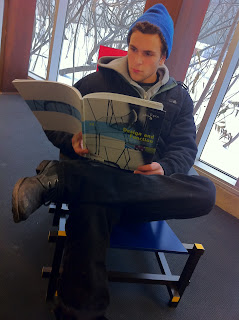Team members: Danny Pizzo, An Huang (http://marshmallowdesign200.blogspot.com/)
We worked together to figure out our first destination, then split the clues up to figure out the most efficient route from the fine arts library. After we had discovered where we needed to go, we went about taking our photographic documentation of the answers.
Clue One
Barcelona Chair by: Mies van der Rohe
The design is said to inspired by ancient Roman folding chairs.
Clue Two
The Red Blue Chair by: Gerit Rietveld
The chair was originally painted gray, black and white, but changed to mimic the color work of Piet Mondrian.
I'm reading an issue of Design and Funtion.
Clue Three
Wexner Center for the Arts by: Peter Eisenman
Controversy surrounds the building's appropriateness as an art gallery, as issues concerning the effect of poor air filtration and high light permeation on artworks in the building have been brought up.
Clue Four
The Math Tower and SEL by: Philip Johnson
Architectural detail which caught my eye was the use of very geometrical shapes on the outside of the structure, particularly patterned circles and semi-circles throughout.
Clue Five
Thompson Library by: Acock and Associates
During the renovation, workers had to remove 1010 tons of limestone and re-install 770 tons inside and outside the building.


































